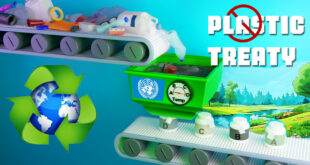An estimated 170 trillion plastic particles weighing about 2 million metric tons are currently afloat in the oceans across the world, according to a new study.
What are microplastics?
- Microplastics are fragments of any type of plastic less than 5 mm in length.
- They cause pollution by entering natural ecosystems from a variety of sources, including cosmetics, clothing, food packaging, and industrial processes.
- Microplastics are particularly harmful to the oceans as they don’t readily break down into harmless molecules and adversely affect the health of marine organisms, which mistake plastic for food.
- Moreover, these particles can trigger loss of biodiversity and threaten ecosystem balance.
Findings of the new study
- From 1990 to 2005, the number of plastic particles more or less fluctuated.
- One of the reasons for this could be due to the effective implementation of important policy measures at the time.
- In the 1980s and 90s, there were some international policies, like MARPOL Annex 5 that enforced laws against dumping trash at sea.
- The concentration of plastic particles including microplastics in the ocean has skyrocketed in the oceans since the mid-2000s, and it continues to increase.
- If the world fails to take any drastic action about the issue, there will be a 2.6-fold increase in plastic flowing into aquatic environments by 2040.
- Impact of microplastics on the oceans and marine life
- Ingestion of such particles can cause mechanical problems, such as lacerations and blockages to internal systems.
- Ingested plastics can cause chemical problems by leaching absorb chemicals into organisms.
- Microplastics absorb many hydrophobic compounds, like DDT, PCBs and other industrial chemicals, and evidence shows they can be released when ingested.
- Microplastics can also disrupt the carbon cycle of the oceans.
- Normally, phytoplankton absorbs carbon and are eaten by zooplankton, who excrete the carbon in the form of faecal pellets that sink to the sea floor.
- Once these carbon-containing pellets reach there, the carbon can be remineralized into rocks — preventing it from escaping back into the atmosphere.
- But if zooplanktons consume microplastics, their faecal pellets sink at a much slower rate.
- They are more likely to break apart or be eaten by other animals making it less likely that the carbon will reach the seafloor and become permanently sequestered.
Way forward:
- There is an urgent need to implement a global resolution to limit the production of single-use, throwaway plastic.
- Cities should be responsible for managing their waste so it does not leave their territory.
- We need to reduce the amount of chemical additives in new plastic products.
- There have to be requirements that recycled plastic be used in new products.
- Industries have to legally be required to put at least 75% recycled plastic in any new product.
SOURCE: THE HINDU, THE ECONOMIC TIMES, PIB
 Chinmaya IAS Academy – Current Affairs Chinmaya IAS Academy – Current Affairs
Chinmaya IAS Academy – Current Affairs Chinmaya IAS Academy – Current Affairs



